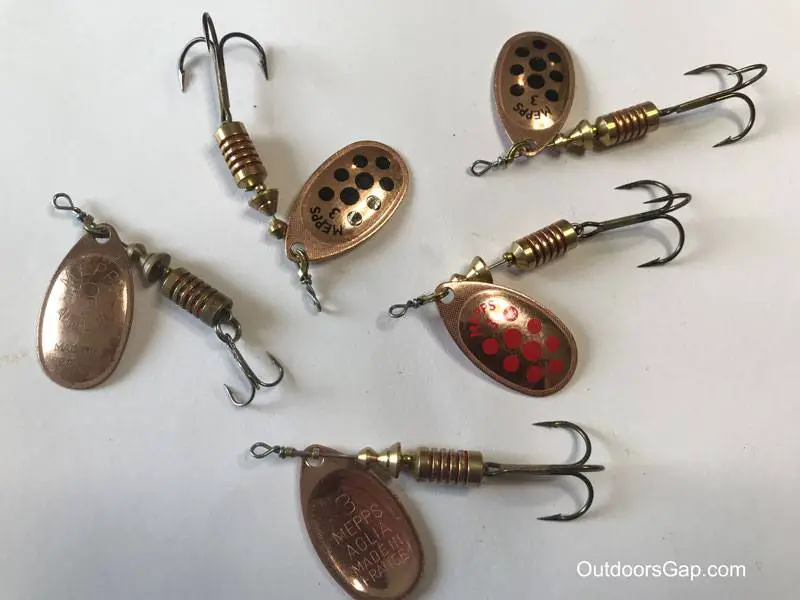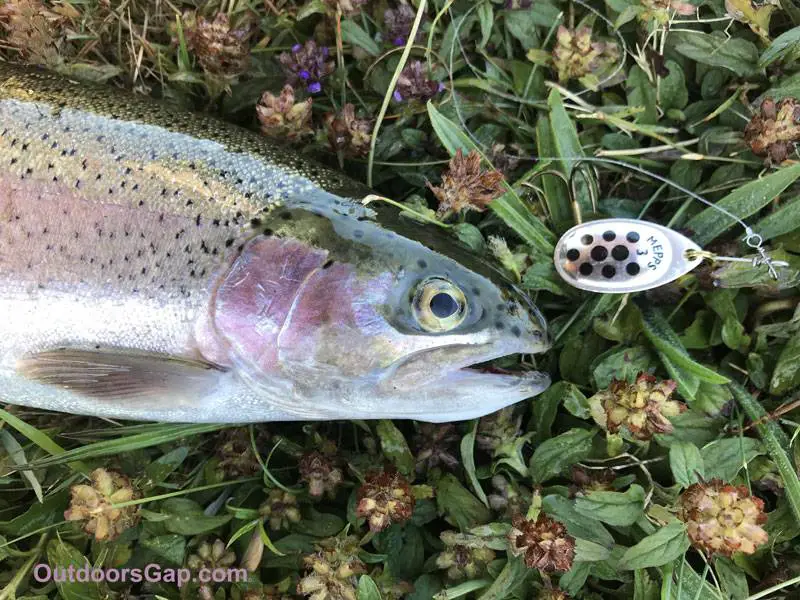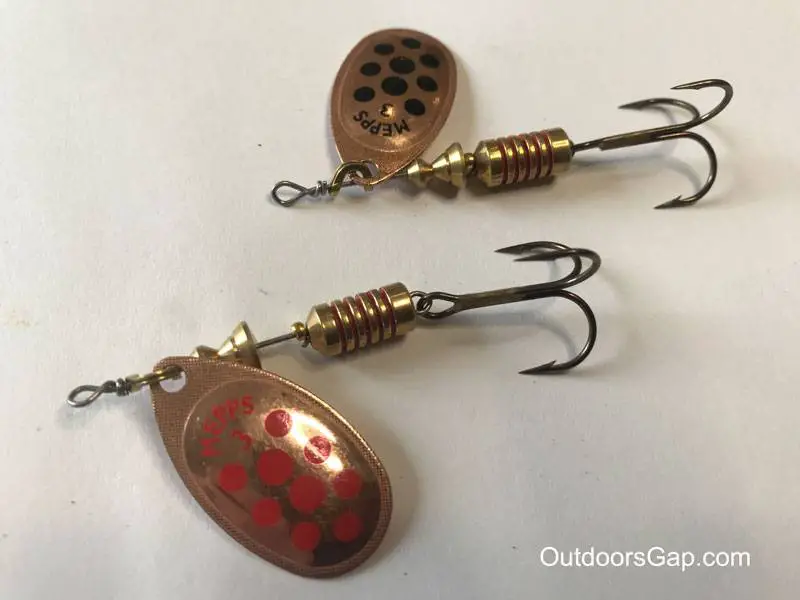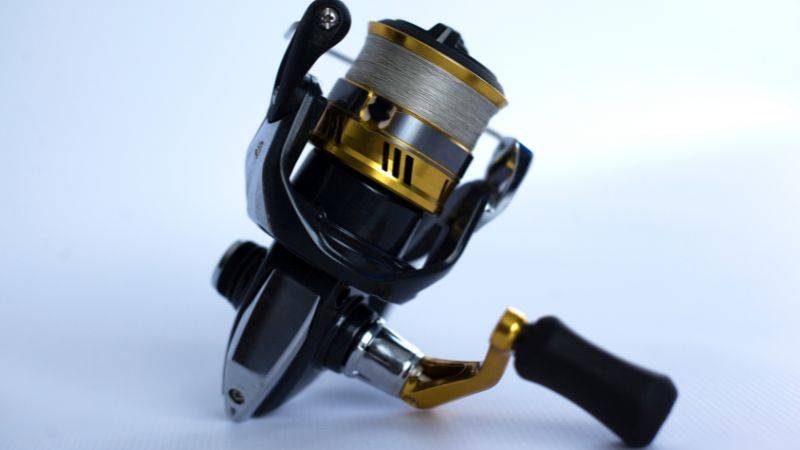
In this article, we will provide information on how to fish Mepps lures effectively and fishing tips. We will also cover the basics of Mepps spinner fishing, including the different types of Mepps spinners, the equipment needed, and the best techniques to use.
Fishing is an exciting and rewarding outdoor activity that requires patience, skill, and the right equipment. One of the essential pieces of equipment for any angler is a good lure. Fishing lures come in many shapes and sizes, but one popular type is the Mepps inline spinner brand.
The Mepps spinners are known for their success in catching a wide variety of fish species, including panfish, trout, bass, perch, pike and more.
Mepps lures are designed to create flash and vibration with their spinning blades. This movement and flash make them irresistible to predatory fish. However, using Mepps spinners requires some basic knowledge and techniques to get the best results.
For more details about the Mepps Aglia spinner, click on – Mepps Aglia Lure
How to Fish Mepps Inline Spinners

Here are a few questions and points to consider, so it can help select the best lure and method for the conditions and fish species.
- What fish species are you targeting?
- What conditions are you fishing in?
- Fishing equipment
- Attaching the spinner
- Casting
- Retrieving the lure and fishing techniques
-
What Fish Species Are You Targeting?
The type of fish you are trying to catch will also play a role in choosing the right Mepps lure.
Here are some size general guidelines for what size Mepps lures to use:
For panfish and small stream trout, opt for Ultra Lites and Wooly Worms in size #00 or #0.
Size #1 and #2 are suitable for stream trout, bluegills, sunfish, and crappies.

Sizes #3 and #4 Aglias are preferred for bigger trout and by largemouth bass fishermen.
(The #3 dressed Mepps Aglia being rated the best all-around lure for largemouth bass by Sports Afield magazine. It is also some of our team’s favorite size for bigger trout.)
Sizes #4 and #5 are ideal for larger fish such as big rainbow trout, steelhead, salmon, pike, and musky.
Keep in mind that these are just general recommendations and may vary depending on the specific fishing conditions.
As an example, in clear small streams with a lot of small species, you might choose a smaller lure. In big lakes with bigger species a larger lure might be more suitable.
-
What Conditions Are You Fishing In?
Different water conditions (water clarity, depth) and environment (weather) will also dictate what type of Mepps spinner you might choose.
Here are some examples:
In clear water, you might use a smaller lure with more subtle colors and smaller size to mimic natural prey.
In murky water, use Mepps lures with a brighter color (or dark silhouette) and larger size to make them more visible to fish.
You might also go for a different type of spinner blade design, like a wider Colorado blade that will give off more vibrations.
For more information of fishing in dirty water, check out this helpful article – How To Fish Murky Water
Fishing in deep water, you might choose a heavier lure to get it down to the bottom quicker and stay a bit deeper on the retrieve.
In fast-moving water, use a lure with a heavier weight to keep them from being swept away and closer to the bottom.
In shallow water, use Mepps lures with a lighter weight to allow for a more natural presentation.
On windy days, you might opt for a heavier lure, like the Mepps Long Cast Lure to help cast into the wind.
Water temperature – Depending on the fish species and season: In colder water, use slower-moving lures. In warmer water, use faster-moving lures.

-
Fishing Equipment
Selecting the Right Fishing Rod and Reel
Choosing the right fishing rod and reel is crucial when fishing with Mepps lures.
The fish species you target, will determine what size rod and reel you need.
Also make sure to use a rod that is suitable to handle the weight of the lure. In this case most inline spinners are reasonable light, so most general spinning rods should be good enough.
A guideline is: if you are chasing small fish, use a small Mepps lure, you will need a light rod and reel.
On the other hand, if you are using a larger Mepps lure, you will need a heavier rod and reel. But as stated, most general range spinning rods should be fine.
When selecting a fishing rod, look for one that is sensitive and has a light action. This will allow you to feel the fish bite and set the hook quickly. A fast action rod will also help you cast the Mepps lure further.
When it comes to reels, look for one that has a smooth drag system and matches the size for your rod.
A good light spinning rod and reel combination will also be a pleasure to cast with. As it is more balanced and designed for the angler to cast for hours.
Choosing The Right Fishing Line
Choosing the right fishing line is just as important as choosing the right rod and reel. The rod should say what size line it is suitable for.
For the main line, you can use braid, fluorocarbon, or straight monofilament (mono) fishing line. If you use braid, you should have a leader attached, which could be either mono or fluorocarbon.
For beginners we would be recommended to just use monofilament for both your leader and main line. (Avoid braid until you get a little bit of experience, as it tangles easily.)
If you use fluorocarbon for the leader, use around a 7-foot length.
The length of the leader will depend on the water conditions, but generally a rods length of leader will do the trick. (In clear water with spooky fish, you might use 2 rods length of leader. So, around a 14 foot length leader.)
Poundage of line will be dictated by the size of the fish you are targeting and the water conditions. As an example, fishing for small trout in a pristine clear water, you might use 4lb line.
For medium size fish, you might use around 6 pounds to 8 pound test.
For big bass and salmon, you might want to use heavier line like 10 plus pounds or more.
Just be aware some lures / soft plastics don’t move well with too thick of line attached to them.
Another thing to consider when choosing fishing line poundage is does the location have a lot of weeds or submerged timber, rocks, where the lure can get snagged. (It hurts loosing lures.)
Go for a heavier poundage line if the water has lots of snags.
For details on avoiding snags, visit – How To Avoid Getting Snagged When Fishing
It is also important to check the fishing line frequently for nicks and abrasions. If the line is damaged, it should be replaced immediately.
(Mepps recommends for the smaller lures that: Use a light action reel and six-pound-test or lighter line; two-pound-test to four-pound-test is better.)
-
Attaching The Spinner

When tying the line to the Mepps lure, use a fishing knot that is strong and secure, like an improved clinch knot, Palomar knot or uni-knot.
Always test your knot first, before casting.
Fishing tip – If you are not great with your knots, practice at home in a controlled environment. It is better learning fishing knots at home, rather than trying to tie them in frustrating windy conditions, or when the fish are jumping.
You can also use snaps, snap swivels or clips, that make changing lures quick and easy.
For just casting a spinner, you generally don’t need a barrel swivel for line twist. Although an inline spinner will get some twist in the fishing line, it normally isn’t too bad though.
For trolling from a boat with an inline spinner, use swivels and anti-twist keels that are designed to reduce line twist and kinks.
-
Casting
Casting a Mepps lure is relatively easy, but there are a few things to keep in mind.
Make sure there are no overhead snags or tree limbs. Also check behind you as well.
Second, aim for a spot where fish are likely to be, such as near structure or features.
Third, use a smooth, fluid motion to cast the lure, being careful not to snap the rod too hard or too fast.
Mepps spinners can also be trolled behind a boat. You don’t have to cast it out, just let the line out to the length you want it out, while the boat is travelling. A faster speed will put the lure higher up in the water. A slower trolling speed will let it stay a bit deeper.
-
Retrieving The Lure And Fishing Techniques

The beauty about Mepps lures is the blade spins well, even with a slower retrieve. (Especially the wider blade on the Mepps Aglia.) However, make sure you are still winding it enough to keep the blade rotating.
Sometimes if the blade doesn’t rotate, a quick jerk of the rod will get the blade to start spinning and then you can keep winding the lure in.
If the fish are deeper be patient and let the lure sink to the desired depth before beginning your retrieve. For deep waters, you can also wind, then pause to let the lure sink more. Have the rod tip low, close to the water to keep the fishing line down, the lure follows this path.
For shallow waters use a smaller lure.
If you use a heavier lure and it is shallow, you might have to wind quicker. Also keep your rod tip up and the lure will retrieve higher in the water column.
For windy conditions or deep waters, use a lure like the Mepps LongCast lure.
The best fishing tip though is to fish where the fish are. I know it sounds obvious, but hear me out. Most freshwater fish will be around some structure like weed beds, timber, rocky outcrops, piers, drop-offs, channels, reefs, points, etc.
Places like these are a haven for small baitfish and aquatic food, so the trout, panfish, or bass, has food as well as cover.
Put in the fishing hours, then you can use local knowledge to pinpoint these structures. If you are fishing from a boat, fish finders with modern features like forward-looking sonar make locating structures and fish easier.
Fish are more likely to strike when the lure is moving at a speed that matches their feeding patterns, environment and seasons. As an example in winter, depending on fish species and location, their metabolism slows down and they feed less often and aggressively.
Experiment with different types of retrieves, such as a steady retrieve, a stop-and-go retrieve, or a fast jerky retrieve, until you find what works best.
The last tip is to be patient. Sometimes you have good days where you catch plenty of fish. Other days you catch zero, zilch, nil, naught, a doughnut, nothing, well you get the point.
Types of Mepps Lures
Mepps lures are available in a huge amount of different designs, colors and types. Here are some varieties of Mepps lures:
- Mepps Aglia
- Dressed Aglia
- Black Fury
- Comet Mino
- Thunder Bug
- Black Fury Mino
- Black Fury MX Mino
- Black Fury Mino Ultra Lites
- Aglia-e
- Aglia Bait Series
- Aglia BRITE
- Aglia Flashabou
- Aglia Long
- Aglia Marabou
- Aglia Streamer
- Aglia Tandem
- Black Fury Tandem
- Bronze Slammer
- Comet Combo
- Comet MX Mino
- Comet TRU-V
- Crawler Harness
- Double Blade Aglia
- Double Blade Aglia Flashabou
- Double Blade Black Fury
- Double Blade Musky Flashabou
- Double Blade Musky Marabou
- Flying C
- Mepps Giant Killer
- Giant Killer Mino
- LongCast
- Magnum Aglia
- Magnum Musky Killer
- Mepps Marabou
- Musky Flashabou
- Musky Killer
- Musky Killer Bait Series
- Spin Flies
- Trolling Rig
- Trophy Series
- Ultra Lites
- USA Aglia
- XD
Lure packs in selected models are also available.
Mepps also has spoons like the: Bantam Syclops, Little Wolf and bucktail jigs.
How Mepps Lures Work

The blade on the Mepps lure spins as it is retrieved through the water, creating vibrations and flashes of light that attract fish.
The size and color of the blade, as well as the type of dressing used, can be customized to suit the type of fish you are targeting.
Jigging Mepps Lures
Jigging an inline spinner is not as a common fishing technique, as the blades can get caught up on the line when it goes up and flutters down. But it can be an alternative method. It is best suited for deeper sections of water (like fishing from a boat or pier.)
You move the lure vertically up and down in the water.
Be sure to keep the line reasonably tight, with little slack and be ready to set the hook at any moment.
Conclusion

Mepps lures are easy to use, versatile and can be used to target a variety of fish species. They are fun to use and simply catch fish.
We hope you enjoyed the information on how to use the Mepps inline spinners and the fishing tips and techniques.
Here are some other articles about inline spinners you might be interested in:
Top Inline Spinners For Fishing
Blue Fox Lures: The Guide to Catching More Fish



